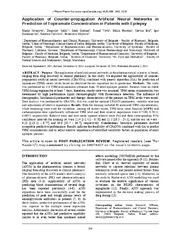| dc.creator | Jovanović, Marija | |
| dc.creator | Sokić, Dragoslav | |
| dc.creator | Grabnar, Iztok | |
| dc.creator | Vovk, Tomaz | |
| dc.creator | Prostran, Milica | |
| dc.creator | Erić, Slavica | |
| dc.creator | Kuzmanovski, Igor | |
| dc.creator | Vučićević, Katarina | |
| dc.creator | Miljković, Branislava | |
| dc.date.accessioned | 2019-09-02T11:46:00Z | |
| dc.date.available | 2019-09-02T11:46:00Z | |
| dc.date.issued | 2015 | |
| dc.identifier.issn | 1482-1826 | |
| dc.identifier.uri | https://farfar.pharmacy.bg.ac.rs/handle/123456789/2366 | |
| dc.description.abstract | Purpose: The application of artificial neural networks in the pharmaceutical sciences is broad, ranging from drug discovery to clinical pharmacy. In this study, we explored the applicability of counter-propagation artificial neural networks (CPANNs), combined with genetic algorithm (GA) for prediction of topiramate (TPM) serum levels based on identified factors important for its prediction. Methods: The study was performed on 118 TPM measurements obtained from 78 adult epileptic patients. Patients were on stable TPM dosing regimen for at least 7 days; therefore, steady-state was assumed. TPM serum concentration was determined by high performance liquid chromatography with fluorescence detection. The influence of demographic, biochemical parameters and therapy characteristics of the patients on TPM levels were tested. Data analysis was performed by CPANNs. GA was used for optimal CPANN parameters, variable selection and adjustment of relative importance. Results: Data for training included 88 measured TPM concentrations, while remaining were used for validation. Among all factors tested, TPM dose, renal function (eGFR) and carbamazepine dose significantly influenced TPM level and their relative importance were 0.7500, 0.2813, 0.0625, respectively. Relative error and root mean squared relative error (%) and their corresponding 95% confidence intervals for training set were 2.14 [(-2.41) - 6.70] and 21.5 [18.5 - 24.1]; and for test set were 6.21 [(-21.2) - 8.77] and 39.9 [31.7 - 46.7], respectively. Conclusions: Statistical parameters showed acceptable predictive performance. Results indicate the feasibility of CPANNs combined with GA to predict TPM concentrations and to adjust relative importance of identified variability factors in population of adult epileptic patients. | en |
| dc.publisher | Canadian Soc Pharmaceutical Sciences, Edmonton | |
| dc.relation | info:eu-repo/grantAgreement/MESTD/Basic Research (BR or ON)/175023/RS// | |
| dc.rights | openAccess | |
| dc.rights.uri | https://creativecommons.org/licenses/by-sa/4.0/ | |
| dc.source | Journal of Pharmacy and Pharmaceutical Sciences | |
| dc.title | Application of Counter-propagation Artificial Neural Networks in Prediction of Topiramate Concentration in Patients with Epilepsy | en |
| dc.type | article | |
| dc.rights.license | BY-SA | |
| dcterms.abstract | Простран, Милица; Јовановић, Марија; Миљковић, Бранислава; Грабнар, Изток; Вучићевић, Катарина; Сокић, Драгослав; Вовк, Томаз; Ерић, Славица; Кузмановски, Игор; | |
| dc.citation.volume | 18 | |
| dc.citation.issue | 5 | |
| dc.citation.spage | 856 | |
| dc.citation.epage | 862 | |
| dc.citation.other | 18(5): 856-862 | |
| dc.citation.rank | M22 | |
| dc.identifier.wos | 000369002800009 | |
| dc.identifier.doi | 10.18433/J33031 | |
| dc.identifier.pmid | 26670371 | |
| dc.identifier.scopus | 2-s2.0-84949767013 | |
| dc.identifier.fulltext | https://farfar.pharmacy.bg.ac.rs//bitstream/id/1063/2364.pdf | |
| dc.type.version | publishedVersion | |

